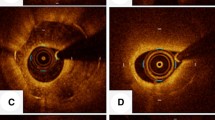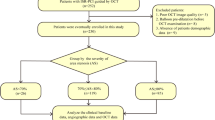Abstract
This study evaluated the impact of optical coherence tomography (OCT)-derived low-backscattered tissue on mid-term coronary endothelial function after drug-eluting stent (DES) implantation. Although OCT enables detailed in vivo evaluation of neointimal tissue characterization after DES implantation, its association with physiological vascular healing response is unclear. Thirty-three stable angina pectoris patients underwent OCT examination and endothelial function testing with intracoronary infusion of incremental doses of acetylcholine 8-month after DES implantation in a single lesion of the left anterior descending artery. Neointimal tissue was classified into two patterns based on the predominant OCT light backscatter: high backscatter and low backscatter. Although the presence of uncovered or malapposed stent strut was not associated with the degree of vasoconstriction, the degree of vasoconstriction was significantly greater in the DES with low-backscattered neointima than in the DES without low-backscattered neointima (− 32.1 ± 25.7 vs. − 4.1 ± 20.1%, p = 0.003). Moreover, there was an inverse linear relationship between low backscatter tissue index and degree of vasoconstriction after acetylcholine infusion (r = 0.50 and p = 0.003). The endothelium-dependent vasomotor response after 8-month of DES was impaired in patients with low neointimal tissue backscatter on OCT imaging. OCT assessment of low-backscattered tissue may be used as surrogate markers for impairment of endothelial function after DES.




Similar content being viewed by others
References
Iwasaki M, Otake H, Shinke T, Nakagawa M, Hariki H, Osue T, et al. Vascular responses in patients with and without diabetes mellitus after everolimus-eluting stent implantation. Circ J. 2014;78:2188–96.
Matsumoto D, Shite J, Shinke T, Otake H, Tanino Y, Ogasawara D, et al. Neointimal coverage of sirolimus-eluting stents at 6-month follow-up: evaluated by optical coherence tomography. Eur Heart J. 2007;28:961–7.
Gonzalo N, Serruys PW, Okamura T, van Beusekom HM, Garcia-Garcia HM, van Soest G, et al. Optical coherence tomography patterns of stent restenosis. Am Heart J. 2009;158:284–93.
Tada T, Kadota K, Hosogi S, Miyake K, Amano H, Nakamura M, et al. Association between tissue characteristics evaluated with optical coherence tomography and mid-term results after paclitaxel-coated balloon dilatation for in-stent restenosis lesions: a comparison with plain old balloon angioplasty. Eur Heart J Cardiovasc Imaging. 2014;15:307–15.
Yonetsu T, Kim JS, Kato K, Kim SJ, Xing L, Yeh RW, et al. Comparison of incidence and time course of neoatherosclerosis between bare metal stents and drug-eluting stents using optical coherence tomography. Am J Cardiol. 2012;110:933–9.
Minami Y, Kaneda H, Inoue M, Ikutomi M, Morita T, Nakajima T. Endothelial dysfunction following drug-eluting stent implantation: a systematic review of the literature. Int J Cardiol. 2013;165:222–8.
Mitsutake Y, Ueno T, Yokoyama S, Sasaki K, Sugi Y, Toyama Y, et al. Coronary endothelial dysfunction distal to stent of first-generation drug-eluting stents. JACC Cardiovasc Interv. 2012;5:966–73.
Fujii K, Kawasaki D, Oka K, Akahori H, Fukunaga M, Sawada H, et al. Endothelium-dependent coronary vasomotor response and neointimal coverage of zotarolimus-eluting stents 3 months after implantation. Heart. 2011;97:977–82.
Fujii K, Masutani M, Okumura T, Kawasaki D, Akagami T, Ezumi A, et al. Frequency and predictor of coronary thin-cap fibroatheroma in patients with acute myocardial infarction and stable angina pectoris a 3-vessel optical coherence tomography study. J Am Coll Cardiol. 2008;52:787–8.
Kim BK, Kim JS, Park J, Ko YG, Choi D, Jang Y, et al. Comparison of optical coherence tomographic assessment between first- and second-generation drug-eluting stents. Yonsei Med J. 2012;53:524–9.
Won H, Kim JS, Shin DH, Kim BK, Ko YG, Choi D, et al. Relationship between endothelial vasomotor function and strut coverage after implantation of drug-eluting stent assessed by optical coherence tomography. Int J Cardiovasc Imaging. 2014;30:263–70.
Takano M, Inami S, Jang IK, Yamamoto M, Murakami D, Seimiya K, et al. Evaluation by optical coherence tomography of neointimal coverage of sirolimus-eluting stent three months after implantation. Am J Cardiol. 2007;99:1033–8.
Kim BK, Kim JS, Oh C, Ko YG, Choi D, Jang Y, et al. Major determinants for the uncovered stent struts on optical coherence tomography after drug-eluting stent implantation. Int J Cardiovasc Imaging. 2012;28:705–14.
Vergallo R, Yonetsu T, Uemura S, Park SJ, Lee S, Kato K, et al. Correlation between degree of neointimal hyperplasia and incidence and characteristics of neoatherosclerosis as assessed by optical coherence tomography. Am J Cardiol. 2013;112:1315–21.
Yonetsu T, Kato K, Kim SJ, Xing L, Jia H, McNulty I, et al. Predictors for neoatherosclerosis: a retrospective observational study from the optical coherence tomography registry. Circ Cardiovasc Imaging. 2012;5:660–6.
Konishi A, Shinke T, Otake H, Takaya T, Nakagawa M, Inoue T, et al. Favorable vessel healing after nobori biolimus A9-eluting stent implantation-6- and 12-month follow-up by optical coherence tomography. Circ J. 2014;78:1882–90.
Lee SY, Shin DH, Mintz GS, Kim JS, Kim BK, Ko YG, et al. Optical coherence tomography-based evaluation of in-stent neoatherosclerosis in lesions with more than 50% neointimal cross-sectional area stenosis. EuroIntervention. 2013;9:945–51.
Nagai H, Ishibashi-Ueda H, Fujii K. Histology of highly echolucent regions in optical coherence tomography images from two patients with sirolimus-eluting stent restenosis. Catheter Cardiovasc Interv. 2010;75:961–3.
Nakano M, Vorpahl M, Otsuka F, Taniwaki M, Yazdani SK, Finn AV, et al. Ex vivo assessment of vascular response to coronary stents by optical frequency domain imaging. JACC Cardiovasc Imaging. 2012;5:71–82.
Fujii K, Hao H, Masuyama T. Can optical coherence tomography findings be used as surrogates for vessel healing after drug-eluting stent implantation? Circ J. 2014;78:1826–7.
Murata A, Wallace-Bradley D, Tellez A, Alviar C, Aboodi M, Sheehy A, et al. Accuracy of optical coherence tomography in the evaluation of neointimal coverage after stent implantation. JACC Cardiovasc Imaging. 2010;3:76–84.
Hofma SH, van der Giessen WJ, van Dalen BM, Lemos PA, McFadden EP, Sianos G, et al. Indication of long-term endothelial dysfunction after sirolimus-eluting stent implantation. Eur Heart J. 2006;27:166–70.
Kim JW, Suh SY, Choi CU, Na JO, Kim EJ, Rha SW, et al. Six-month comparison of coronary endothelial dysfunction associated with sirolimus-eluting stent versus Paclitaxel-eluting stent. JACC Cardiovasc Interv. 2008;1:65–71.
Nakata T, Fujii K, Fukunaga M, Shibuya M, Kawai K, Kawasaki D, et al. Morphological, functional, and biological vascular healing response 6 months after drug-eluting stent implantation: a randomized comparison of three drug-eluting stents. Catheter Cardiovasc Interv. 2016;88:350–7.
Tanaka N, Terashima M, Rathore S, et al. Different patterns of vascular response between patients with or without diabetes mellitus after drug-eluting stent implantation: optical coherence tomographic analysis. JACC Cardiovasc Interv. 2010;3:1074–9.
Nakazawa G, Shinke T, Ijichi T, et al. Comparison of vascular response between durable and biodegradable polymer-based drug-eluting stents in a porcine coronary artery model. EuroIntervention. 2014;10:717–23.
Hoymans VY, van Dyck CJ, Haine SE, et al. Long-term vascular responses to Resolute® and Xience V® polymer-based drug-eluting stents in a rabbit model of atherosclerosis. J Interv Cardiol. 2014;27:381–90.
Hamilos M, Sarma J, Ostojic M, et al. Interference of drug-eluting stents with endothelium-dependent coronary vasomotion: evidence for device-specific responses. Circ Cardiovasc Interv. 2008;1:193–200.
Sumida A, Gogas BD, Nagai H, et al. A comparison of drug eluting stent biocompatibility between third generation NOBORI biolimus A9-eluting stent and second generation XIENCE V everolimus-eluting stent in a porcine coronary artery model. Cardiovasc Revasc Med. 2015;16:351–7.
Acknowledgements
The authors thank the staff in the catheterization laboratory in Hyogo College of Medicine for their excellent assistance during the study.
Author information
Authors and Affiliations
Corresponding author
Ethics declarations
Conflict of interest
The authors report no financial relationships or conflicts of interest regarding the content herein.
Rights and permissions
About this article
Cite this article
Tamaru, H., Fujii, K., Nakata, T. et al. Impact of low tissue backscattering by optical coherence tomography on endothelial function after drug-eluting stent implantation. Cardiovasc Interv and Ther 34, 164–170 (2019). https://doi.org/10.1007/s12928-018-0540-y
Received:
Accepted:
Published:
Issue Date:
DOI: https://doi.org/10.1007/s12928-018-0540-y




